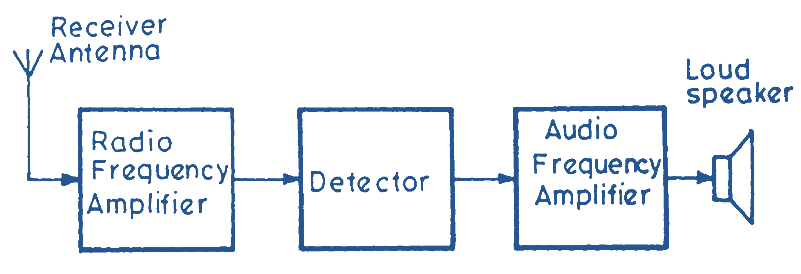A radio receiver is a device that receives the radio waves propagated by a desired radio transmitter, recovers modulating signals from these waves and gives sound output.
In order that a radio receiver reproduces the modulating signal effectively, it must possess the following characteristics.
- It should pick up radio waves from the free space.
- It should select a desired radio wave out of the several waves present in the free space at that time.
- The picked up signal is very weak and must be amplified to an appropriate level.
- The signal must be demodulated to obtain the modulating signal.
- The demodulated signal must be amplified to a sufficient before it is converted into sound waves.
Straight Radio Receiver

Fig. 1. Block diagram of a Straight radio receiver.
Straight radio receivers were the first radio receivers developed and are no longer in use. The straight radio receiver circuit was designed to perform all the necessary functions listed in the preceding paragraphs. Fig. 1 gives the block diagram of a straight radio receiver.
The receiver antenna picks up the radio waves present in the region where antenna is located and converts these waves into electrical signals. The antenna is not able to differentiate between signals present in the region of the aerial at that time. These signals are given at the input of the radio frequency amplifier.
The radio frequency amplifier employs two or three stages of tuned voltage amplifiers. These amplifier stages allow signal frequencies that correspond to a narrow band around the resonant frequency of the tuned voltage amplifier. In other words, desired signal frequencies are selected and amplified by these amplifier stages. Signals other than the desired signal are rejected by the tuned circuits. The output of the radio frequency amplifier is given to a diode detector to recover the AF output.
The audio output obtained from the detector is amplifier by AF amplifier to a sufficient magnitude to drive the loudspeaker. The loudspeaker converts the audio currents into sound waves.The straight receivers suffered from certain limitations due to which they are in use now a day. These limitations are;
(i) In order to tune the straight receiver to a desired station, all the resonant circuits must be tuned simultaneously. Therefore we have to mount the tuning capacitors of all these resonant circuits on one spindle (ganged together) which is not only costly but also occupies large space. Another drawback that is encountered is that there is a considerable variation in the circuit Q between the closed and open positions of the tuning capacitor.
(ii) The receiver not only reproduces a desired signal. It also reproduces signals having frequencies close to the frequency of the desired signal. Such an interference is termed as adjacent channel interference and is troublesome in straight receivers.